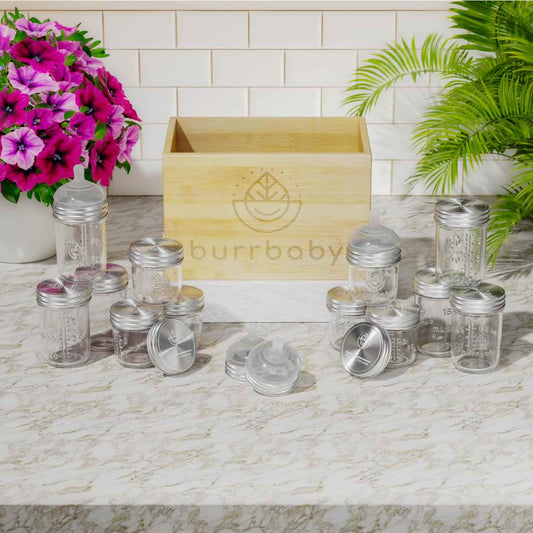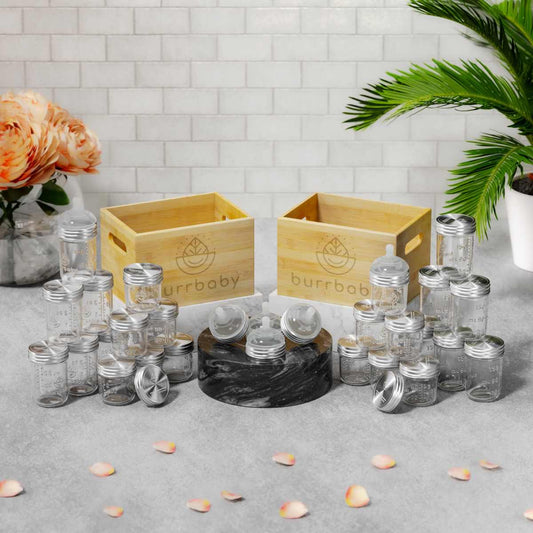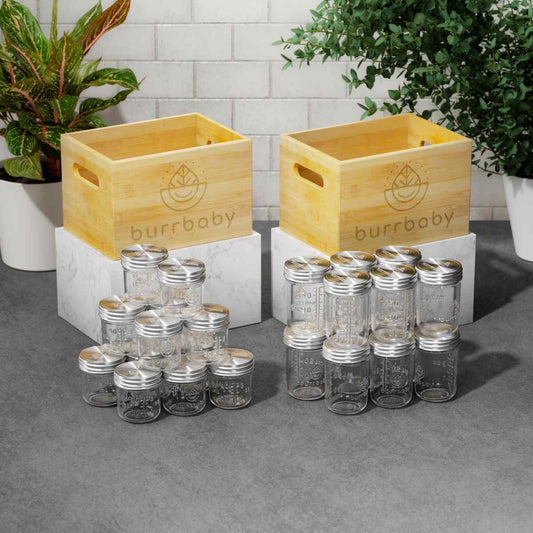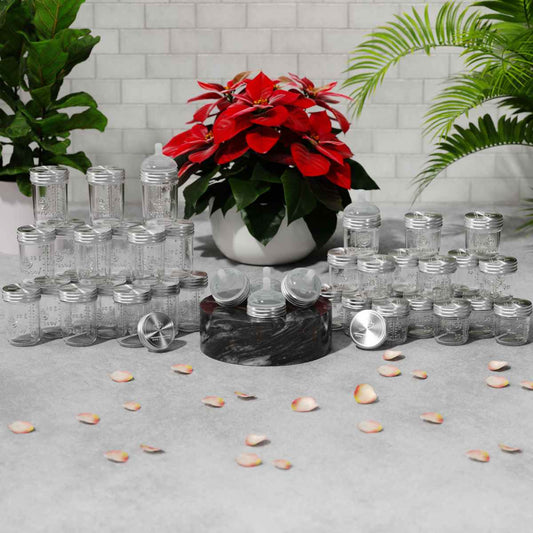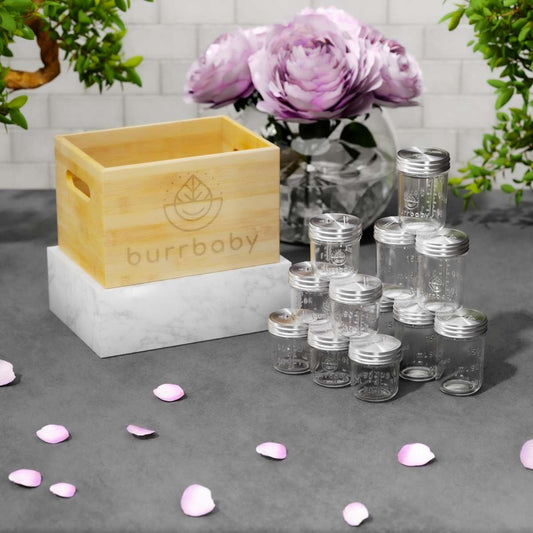Following correct breast milk storage practices is a crucial step to ensuring your baby receives the best and safest possible nutrition. As a new parent, navigating all of the different information on this topic can be overwhelming, but understanding the fundamentals of breast milk storage is a necessary skill.
I know it was overwhelming for me, so hopefully this can help!
In this blog post, we will dive into how long breast milk can safely sit out and provide guidance on identifying when it may have gone bad.
Article Overview
- How long can breast milk sit out?
- How to tell if breast milk is bad.
- Proper handling techniques to prevent spoilage.
- Best practices for breast milk storage.
- Benefits of using glass containers for storage.
At Burrbaby, we're dedicated to being a part of a healthier world for your children. We do this through our zero-plastic glass breast milk storage containers and bottles. These completely non-toxic, sustainable choices protect your baby's health and our planet.
How Long Can Breast Milk Sit Out?
There are several factors that can influence the length of time breast milk can be left out at room temperature. This section will explore these factors and provide guidelines to help you make the best decisions for your baby's health.
Factors Affecting Breast Milk Storage Time
Temperature is the main determinant of how long breast milk can be safely stored outside the refrigerator or freezer. Both the temperature of the room and the temperature at which the milk was expressed can impact the milk's longevity. Other factors, such as the cleanliness of the pumping equipment and containers, can also affect how long breast milk can sit out.

General Guidelines for Breast Milk at Room Temperature
According to the Academy of Breastfeeding Medicine, freshly expressed breast milk can safely sit at room temperature (up to 77°F or 25°C) for up to four hours. However, it is always best to refrigerate or freeze the milk as soon as possible to preserve its quality and nutritional content.
If the room temperature is higher than 77°F (25°C), the storage time should be reduced to a maximum of two hours to minimize the risk of bacterial growth. Remember, these guidelines are for freshly expressed milk; if you have previously refrigerated or frozen the milk, the recommended storage times may be shorter.
It's also never recommended to thaw and refreeze breast milk, or to let refrigerated breast milk come to room temperature, and then go back in the fridge for storage. It's so hard to dispose of our hard-earned breast milk, but sometimes we have to do it for the safety of our babies.
Ideal Storage Conditions
Ensure that the milk is collected and stored in clean, airtight containers, ideally made from materials that do not leach harmful chemicals. We believe glass containers are ideal choices for this purpose as there is no risk of chemical leaching or microplastics getting into the milk.
Keep the containers away from direct sunlight, as exposure to UV light and heat can reduce the milk's nutritional content.
Read more about tips for storing breastmilk in the refrigerator and freezer here.
How to Tell if Breast Milk is Bad
The thought of feeding your baby spoiled breast milk is a scary one, but luckily there are a few signs it might have gone bad.
Visual Indicators
Breast milk can exhibit a range of natural colors, from bluish to yellowish, depending on your diet and the time of day. However, if the milk develops an unusual or off-color, such as green, orange, or brown, it could indicate spoilage. Therefore, always inspect the color of your breast milk to ensure it is safe for your baby.
It's normal for breast milk to separate into a creamy layer and a watery layer when stored. However, if the milk appears unusually clumpy or has visible chunks, it may be a sign of spoilage. Gently swirl the container to mix the layers before feeding your baby, and check for any abnormal consistency.
Smell and Taste
Breast milk can have a slightly sweet or soapy smell due to the presence of lipase, an enzyme that helps break down fats for digestion. This is normal and not a cause for concern.
If your breast milk has a sour or rancid smell, it may have gone bad. Spoiled breast milk may also taste bitter or sour. If you're unsure, it's best to discard the milk and express a fresh batch for your baby.

Proper Handling Techniques to Prevent Spoilage
To reduce the risk of spoilage, always wash your hands thoroughly before handling breast milk and use clean (sterilized if you're using glass) containers for storage. This is the final step in protecting your milk from outside bacterial contamination.
Following the storage guidelines outlined above can also help maintain the quality and safety of your breast milk.
In conclusion, regularly inspecting your stored breast milk's color, consistency, smell, and taste (taste is typically reserved for cases where you are really worried) can help ensure its safety and quality for your baby. Also, remember to follow proper handling and storage guidelines to minimize the risk of spoilage.
Best Practices for Breast Milk Storage
Refrigeration and Freezing Guidelines
Storing breast milk in the refrigerator is a safe method to maintain its quality and nutritional value. For optimal freshness, it is recommended to store breast milk in the back of the refrigerator, where the temperature is most consistent. Keep in mind that your breast milk should only be stored for up to four days at temperatures around 38°F (4°C) or 40°F (4.4°C).
Freezing is an excellent option if you plan to store your breast milk for an extended period. Frozen breast milk can be stored for up to six months in a standard freezer or up to 12 months in a deep freezer. When freezing breast milk, leaving some space at the top of the container is important to allow for expansion as the milk freezes.
Many of these guidelines can be found on the CDC's webpage for breast milk storage safety.
https://www.cdc.gov/breastfeeding/recommendations/handling_breastmilk.htm
Thawing and Warming Techniques
To thaw frozen breast milk, place it in the refrigerator overnight or use cold/warm water to expedite the process. Avoid using the microwave or hot water, as these methods can destroy valuable nutrients and, if heated too much, could hurt your baby.
Warming
Warm the breast milk by placing the container in a bowl of warm water or using a bottle warmer specifically designed for this purpose. Gently swirl the milk to distribute the heat evenly. Always check the temperature before feeding by dripping a small amount on your wrist to ensure it's not too hot.
There really shouldn't be any shortcuts used here like hot water or microwaving. I might be a bit repetitive here, but it's important.
Benefits of Using Glass Containers for Storage

Storing breast milk in glass containers, such as those offered by Burrbaby, is a healthier and more sustainable option compared to plastic storage containers.
Glass is non-toxic and free from potential harmful chemicals found in plastic that can leach into the milk. Plastic breast milk containers have also been shown to release microplastics into milk as well.
When it comes to cleaning, glass is far superior. With Burrbaby's wide neck, they are easy to clean and sterilize. Plastic containers should not be heat sterilized due to the degradation of the material. Glass is also non-porous and very scratch resistant, which makes bacterial growth less prevalent, and it doesn't hold odors or soapy residue like plastic.
Glass containers provide a versatile and long-lasting solution for breast milk storage. They can be easily transitioned from storage to feeding with the addition of compatible bottle conversion nipples. Burrbaby's bottle conversion nipples turn any of our jars, or your own small mouth mason jars, into a feeding bottle.
They can also be reused and repurposed for food storage as your child grows, making them a cost-effective and environmentally friendly choice.
Learn more about the benefits of using glass containers for breast milk storage.
Conclusion
As a new parent, it is crucial to prioritize breast milk safety and quality to ensure your baby is safe. By following the guidelines and best practices discussed in this guide, you can create a safe and nourishing environment for your little one. You don’t have to be perfect and do the best you can.
And as always, when in doubt, throw it out. It's hard saying goodbye to your liquid gold, but nothing is worse than baby getting sick, or just the stress and anxiety you'll have wondering if it was ok.
References
American Academy of Pediatrics. Breastfeeding and the Use of Human Milk. https://publications.aap.org/pediatrics/article/150/1/e2022057988/188347/Policy-Statement-Breastfeeding-and-the-Use-of
Cleveland Clinic. (2020). Want to Be a Better Parent? Start by Taking Care of Yourself https://health.clevelandclinic.org/want-to-be-a-better-parent-start-by-taking-care-of-yourself/
Family Doctor. Breastfeeding: Hints to help you get off to a good start. https://familydoctor.org/breastfeeding-hints-to-help-you-get-off-to-a-good-start/
Johns Hopkins Medicine. Breast Feeding: Getting Started. https://www.hopkinsmedicine.org/health/conditions-and-diseases/breastfeeding-your-baby/breast-feeding-getting-started
La Leche League International. (n.d.). Storing human milk. https://llli.org/breastfeeding-info/storingmilk/
Centers for Disease Control and Prevention. (2020). Proper storage and preparation of breast milk. https://www.cdc.gov/breastfeeding/recommendations/handling_breastmilk.htm
ABM Clinical Protocol. (2017). Academy of Breastfeeding Medicine Protocol #8: Human Milk Storage Information for Home Use for Full-Term Infants. Breastfeeding Medicine, 12(7), 390-395. https://www.liebertpub.com/doi/10.1089/bfm.2017.29047.aje
Balakrishnan B, Henare K, Thorstensen EB, Ponnampalam AP, Mitchell MD. Transfer of bisphenol A across the human placenta. Am J Obstet Gynecol. 2010 Apr;202(4):393.e1-7. doi: 10.1016/j.ajog.2010.01.025. PMID: 20350650. https://pubmed.ncbi.nlm.nih.gov/20350650/
La Leche League International. Milk Issues https://llli.org/breastfeeding-info/milk-issues
Lawrence PB. Breast milk. Best source of nutrition for term and preterm infants. Pediatr Clin North Am. 1994 Oct;41(5):925-41. doi: 10.1016/s0031-3955(16)38839-3. PMID: 7936781. https://pubmed.ncbi.nlm.nih.gov/7936781/
Boquien CY. Human Milk: An Ideal Food for Nutrition of Preterm Newborn. Front Pediatr. 2018 Oct 16;6:295. doi: 10.3389/fped.2018.00295. PMID: 30386758; PMCID: PMC6198081. https://pubmed.ncbi.nlm.nih.gov/30386758/



